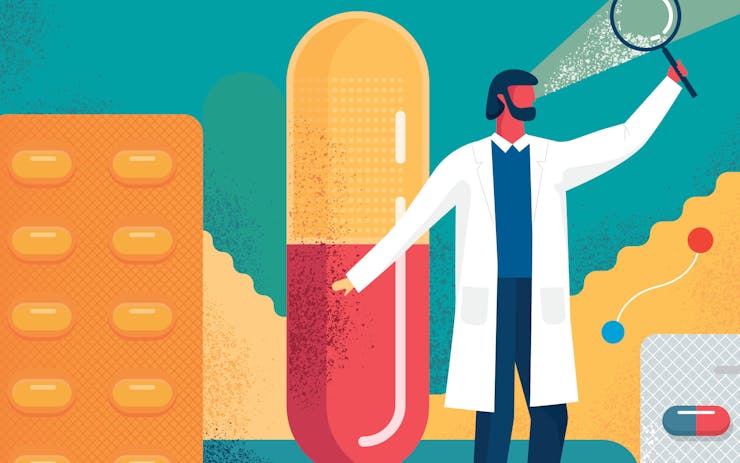It’s 2019 and we still live in a world where one small study, on mice, with a highly questionable methodology, published in a marginal journal, with major flaws, leads to a clickbait media panic.
Recently, you may have seen a Forbes article headlined “Marijuana Study Finds CBD Can Cause Liver Damage” that reported on a study out of the University of Arkansas for Medical Sciences.
It’s scary stuff:
Shockingly, researchers discovered that the mice given higher doses of CBD showed signs of liver damage within 24 hours. To that end, 75 percent of these animals in the sub-acute phase had either died or were on the verge of death within a few days.
But this panic and misinformation is nothing new—back in 1974, a study conducted at Tulane University supposedly showed that “the active ingredient in marijuana [THC] impairs the brain circuitry,” leading the press to dutifully run articles claiming that pot causes brain damage without a trace of skepticism.
The 1974 study was deeply flawed. In Smoke Signals: A Social History of Marijuana, author Martin Lee called out this exceedingly small study of rhesus monkeys as “a textbook case of scientific fraud”:
Shackled in air-tight gas masks, Heath’s monkeys were [regularly] forced to inhale the equivalent of 63 high-potency marijuana cigarettes in five minutes. Lo and behold, the primates suffered brain damage from suffocation and carbon monoxide poisoning, but Heath attributed the results to marijuana toxicity.
Lucky for us—if not Forbes readers—Project CBD, a non-profit dedicated to boosting science-based understanding of cannabidiol (CBD), have just released a detailed rebuttal to the Forbes article.
The Rebuttal
Much has changed in the last forty-five years, but the National Institute on Drug Abuse (NIDA) still holds a monopoly on the sole supply of cannabis that can be used for federally-approved studies. And the research they approve remains laser-focused on finding harm—either that or trying to create a pathway to patenting synthetic THC as a prescription drug.
Regardless of your feelings on the CBD study, it is hard to argue with dead mice—even if you are an all-knowing marijuana expert.
Mike Adams, author of the Forbes, wrote another article in which he claims there’s no such thing as an expert in cannabis because not enough is known about the plant and its effects on human beings. That’s a highly questionable claim, and I suppose it explains why he didn’t quote anyone in his article who might have poured cold water on the study’s more alarming claims.
For example, Project CBD.
In their rebuttal of the Forbes article, Project CBD says:
The breathless reporting in Forbes focuses on a single, flawed, preclinical study and exaggerates it to the point of falsehood… A close examination of the Molecules study reveals a Pandora’s box of strange statements, problematic publishing, and unreasonable experimental design. On the first page, the abstract makes a claim that is fundamentally impossible, stating that, with chronic administration of CBD, ‘75% of mice gavaged with 615 mg/kg developed a moribund condition.’ But there were only 6 animals that received this dose! One doesn’t need an advanced degree in science or math to recognize that something is amiss. Seventy-five percent of six equals 4.5.
Dead mice aside (or rather, dead half-mice), the biggest problem with the study, according to Project CBD, is that just like in the 1974 rhesus monkey study, the dosage administered was astronomically high.
Scientists force-fed mice a single dose of CBD, ranging from the supposedly ‘low’ dosage of 246 mg/kg up to a mega-dose of 2460 mg/kg CBD… The maximum human dosage recommended for the CBD-isolate Epidiolex is 20 mg/kg, which is over 100x less than what the Little Rock researchers force fed their experimental mice.
The researchers explain away this mega-dosing by pointing to something called allometric scaling, which is basically a set of guidelines for estimating an equally potent dose of a substance for humans and other animals based on body weight and body-mass index.
But Project CBD argues that allometric scaling is a rule of thumb at best, and cannabinoids in particular are a very poor fit for the model: “The ridiculously high doses in this study will saturate the body’s metabolic machinery, preventing relevant dose-extrapolations.”
Shop highly rated dispensaries near you
Showing you dispensaries nearFalse Claims in a Sketchy Journal
In their critique of the study, Project CBD flatly charged the University of Arkansas researchers with producing “A hit piece against CBD, not legitimate scientific work.”
Specifically, the Project CBD article cites instances of cherry-picking previous research on CBD to downplay benefits and hype harms, which obscures how unreliable past studies on mice have been in predicting how humans will react to cannabinoids, and which also presents false or deliberately misleading information.
Project CBD points to the study’s claim that “numerous reports have demonstrated neurological, cardiovascular and reproductive toxicities subsequent to CBD use”—the researchers cited nine sources to back that claim, but the only one to actually involve humans did not show toxicity.
In fact, when contacted by Project CBD, Saoirse O’Sullivan, that study’s lead author, said, “Our research showing that CBD causes a small reduction in resting and stress-induced blood pressure does not support the authors’ claim that we demonstrated cardiovascular toxicity of CBD. In fact, most of our work is about the potential protective effects of CBD in the cardiovascular system.”
Project CBD also called into question the credibility of Molecules, the journal that published the CBD liver study.
MDPI, which publishes the journal Molecules, has been called a predatory publisher. MDPI has been criticized for publishing unsound articles… Even if such allegations are true, it doesn’t mean that good work can’t end up in one of MDPI’s 213 journals. But it underscores the importance of checking scientific work, rather than diligently repeating and amplifying whatever claims are presented.
And that really gets to the heart of the issue.
Because it’s 2019, and we still live in a world where one small study, on mice, with highly questionable methodology, published in a marginal journal, with major flaws, can lead to articles like the one in Forbes.
Which get clicks for sounding the alarm—without a legitimate reason to do so—while simultaneously drowning out more reasoned discussions of CBD’s potential dangers, and how they can best be mitigated.
A Final Thought Experiment
One thought experiment occurred to me while researching this article.
I came across this Leafly article describing a day of testimony this past May before the FDA. In particular, I was struck by the words of Alice Mead, on hand to represent the interests of GW Pharmaceuticals, which specializes in developing pharmaceutical drugs extracted from cannabis plants—including Epidiolex, the world’s first FDA-approved CBD drug.
Normally, when Big Pharma talks to the FDA about their products, they make every effort to present the rosiest picture possible. But Mead took pains to mention that CBD is “potentially toxic to the liver” and “has powerful drug-drug interactions.”
But the real tell was when she argued for a “strong regulatory framework.”
Because what that really means is GW Pharmaceuticals wants a regulatory framework for CBD so strong that only they can surmount it. Leafly has been reporting on the company’s attempts to win temporary monopolies for its products in a number of US states since 2017, and there’s certainly no reason to believe GW wouldn’t prefer a blanket monopoly on the entire country.
And so here’s the thought experiment:
You’re GW Pharmaceuticals, and you’ve invested heavily in both time and money to create a patented CBD drug. Now you’re about to go to market, and want to make a huge return on that investment without having to compete with CBD hamburgers and truck stop snake oil.
So what’s the biggest threat to your bottom line—that people think CBD is too dangerous, or that people think CBD is too safe?







